A chiropractor discusses how he uses kettlebells as both a diagnostic and therapeutic tool with his patients — and how he personally transformed his body and his energy with kettlebells.
A kettlebell success story interview with Dr. Kevin Cooper
January 18, 2011 09:44 AM
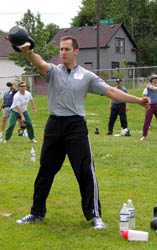
Dr. Kevin Cooper is a chiropractor and a certified strengthening/conditioning specialist from Boston, Massachusetts, with an office in Norwood, Massachusetts. John Du Cane from Dragon Door interviewed him at Pavel's June 2004 Russian Kettlebell Challenge certification.
Kevin: I've been in the fitness field close to 20 years and have been a personal trainer for approximately 18 years. I have in that time worked at sports medicine facilities doing tons of rehab, injury rehab, post-surgical rehab, as well as sports conditioning. So, this has been my whole life.
I've been a chiropractor for seven years in practice. I've worked with many figures from both the entertainment and professional sports worlds.
I became aware of Pavel through his writings in a supplement review book and it just basically tore through the misty curtains of conventional gym wisdom that were out there.
The prevailing scheme of thought that I knew was wrong but I couldn't quite put my finger on why it was wrong or what I was doing. I just knew that it wasn't working.
For instance, I estimated, probably conservatively, that I was doing approximately 2000 crunches a day with all of my clients. And yet, my abs were not really anything to speak of.
I certainly was not in bad shape, but I didn't have the other-worldly cheese grater definition that you would expect to see of someone doing that much volume.
So, when I read Pavel's stuff, it was like literally being pole axed. I just said [one finger snap', "Bingo! This is it!"
Again, through his writings I then became aware of kettlebells. The first time that I got a hold of one and actually tried to move it, I realized that this pits every muscle in your body against the resistance and this is what everyone needs as far as conditioning and changing postural distortions.
In my business, I see my practice as correcting postural distortions. That is what I do 98% of the time.
Everyone comes in with something. And, whatever you come in with, it's because of what you do and how you do it. We are what we do. Form follows function. It all boils down to that. So, what do we do? Well, we sit a lot.
We work on things that are in front of us, like desk work, computer work, and phone work. Everything is designed to compact you to bring you forward, to shorten, tighten, atrophy if you will. And, kettlebells bring you up out of that. So, in my practice it's all about opening everything up.
And, I make all my clients/patients work out. Every one lifts. Every one does, beyond the sit-ups with the Ab Pavelizer, everyone stretches and most everyone gets mobilized or adjusted and gets soft tissue work done.
This has basically catapulted my practice. It's catapulted me personally, because I'm a product of this process.
Around the time that I discovered Kettlebells. I was approximately 225, around 50 lbs. overweight.
The combined stresses of opening a brand new practice, having young children, buying a big house, all of this…I allowed myself to become wrapped up in that and forget about me the practitioner, me the husband, me the father. And, I let myself totally go by the wayside
Basically I had a mini-nervous breakdown in a Marshall's dressing room and I realized that all the 36 waist pants had been mis-marked. I could no longer squeeze my enormous tush into them
And, after I did that I took a look at myself in the mirror and what I saw was an old, out of shape, fat man. And, I said, that is not me. That is something that I have become. That is something that I have allowed myself to appear as, but that's not me.
And, it was just at that time, to say when you are ready to teach it will appear. I was ready. Pavel appeared. Kettlebells appeared. And, that's when the transformation started. Currently, I weigh in at 177. I've not weighed under 200 lbs. since college. I've been married for twelve years. My wife says that basically I look better than I did when we got married.
It's been an amazing transformation. And, my patients who know me, it has drawn them to me, because now, every day I just can't wait to get to work. I am so energized. I work 7,8,9,10,11 hour days. I work out. I have a two-hour break during the middle of the day so that I can work out and spend some time with my kettlebells.
And, my day's very physical. I stretch people by hand. I do proprioceptive stretching—which technique has become turbo charged by Pavel's teaching. I do myofascial release work. It's just very, very, very physical and I have energy to burn.
I feel darn good today. This is our third day and it's amazing. It's absolutely amazing and it's a testament to the Qigong Recharge that you did. I tried to get my head up off of the pillow this morning, and I couldn't believe of how aware of every muscle in my body I was.
And, that's another critical, critical things that kettlebells teaches is that it teaches you to be aware of your body. And, now you know where the power leakages are, because you cannot lie to that bell. You cannot finesse the bell. You cannot prevaricate. You cannot make excuses. The bell knows if you're committed to the lift, whatever that lift may be.
So, very clearly the power leaks, the weak links in the connect chain all stand out in plain relief, which to a practitioner is just such a Godsend, because it's like having a moving x-ray on every patient that comes in. It's automatic, "Boom. There it is. There is the weakness." Now, once we know what the issue is, you can take your steps to remedy that.
John: Fantastic.
Kevin: Yeah. I use the kettlebells both as a diagnostic tool and as a therapeutic tool.
John: So, how has the experience of the kettlebell workshop been? You've already been doing kettlebells for a year.
Kevin: The amazing thing is, and I've said this multiple times throughout this weekend is, that I thought I was good. Up to this point. I thought, "Man, I am skilled. I am clean. I am crisp." And, just the level of clarity that I have now about not only my own technique, but the techniques that I've employed with other people has just been absolutely startling. When you take somebody like myself…I've got 18 years of experience. I'm not a piker.
I've been lifting forever. I mean, I've done the USAW weight lifting course and studied their materials. I know my way around the gym. So, just to have the expertise of the individuals that you have here, the depth and breadth of the knowledge and to be able to impart that in a 72 hour period is absolutely astonishing.
I am so much more aware of my body now and the purity of movement that you need to aspire to. You might not get to that over this weekend. There is a lot to learn and a lot of it is highly evolved. But, now I have tools. I know what to work on. I know what my weaknesses are. I can shore that up now with the tools that I've gleaned from this workshop.
If you've come in here and if you think you are good, you are not. If you think that you are skilled, you are not. If you think that you are hard core, you are not. But, you will be, after this, most definitely, it's fantastic.
John: So, how do see bringing kettlebells to people in your practice now? I mean, you've already doing it to a certain extent.
Kevin: And, basically I have been turning a lot of people onto the website, onto the writings, and it is basically my goal to take my area of the country and …it is going to become kettlebell country.
Because I want people to know, not only the fallacy of the conventional gym wisdom, the improper biomechanics that are taught by machines…the lack of focus, the lack of efficiency, the harmful nature of things of a lot of the things that people do.
Because, we are creating a generation of people who are basically walking land mines. They have time bombs ticking that they don't even know.
But, the back pain is coming. The degeneration is coming, because it's ongoing. It's an ongoing process and they do it every single day like sand through the hour glass, these are the days of our lives. And, these are the future medical bills that are racking up.
But, that doesn't have to be. You can see Steve Maxwell, 53 years old….
John: Yeah. Steve Maxwell crawling across the field…
Kevin: Lugging cannon balls.
John: Amazing.
Kevin: And, leading the pack…and looking down saying, "Come on. Let's go. You know, I can get my heel up to my opposite hand, Why can't you? I'm 53 years old, and you're dropping into that front swan with your butt on your calves. Okay. Let's do a 100 of these things." —Oh, yeah, my thighs are going to explode after ten, thank you!
I said this before I came here, but now I believe it so much more firmly, "You can do whatever you want to do, as long as you want to do it, but you have to be willing to pay this price."
What sort of conditioning steps are you going to undertake to maintain this marvelous machine that you've been blessed with?
And, you either pay the price now, in terms of how you are going to train yourself. Or, you're going to pay later on in terms of medication, medical bills, having to give up this, having to give up that, as if that's a normal part of life. "Oh, I can't do that anymore, I've had to cut down because of age."
It angers me to no end to see people feeling that it's normal to settle for restrictions. And, I think it's a crying shame when I hear that sort of tale. So, here's a tool. Here's the fountain of youth, if you will, for as long as you want, go to work.
Here are the tools. So, now I've been gifted with tools as a result of this weekend. And, I can bring that to people. I'm so excited. There are individuals, there are patients in my practice where very specifically during the course I said, "Yes, this is going to help that person!"
John: What sort of things have those patient's got that you can see helping with?
Kevin: Well, for instance, there's a patient of mine who is an amputee. He has a hip that is locked, it's immobile, and as a result of that it's caused lots of postural distortion and he's having a hard time walking. He's having a hard time ambulating.
So, there was one drill that we did, very specifically…I can't wait to introduce it to him, because I know it's going to make a difference. It made a difference of me just in the space of ten seconds. I know what it's going to do for him. I know it's going to be absolutely outstanding.
People with back pain, with weak abs, with kyphotic postures (hunchback type of postures), here it is. Here is a weaponry with which we are going to reshape that body and pull you back into a normalized posture and take some pressure off of yourself.
Literally, I cannot think of anyone in my practice that this is not going to help.
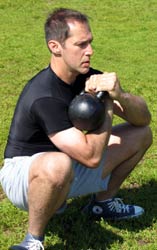
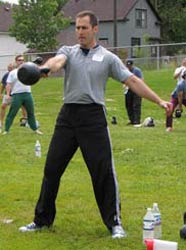
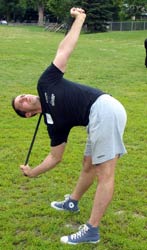
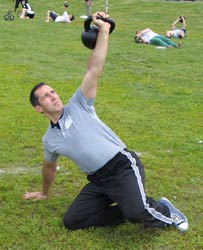
Dr. Kevin Cooper is a chiropractor and a certified strengthening/conditioning specialist from Boston, Massachusetts. He can be reached at kcsportsdoc@hotmail.com.
Back